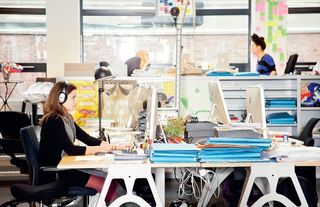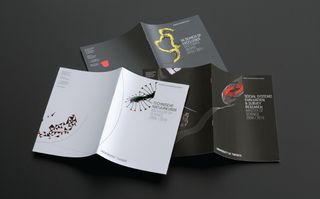Dawn of the living services
In future, we won’t just access online services through computers and mobiles – our homes, and even our bodies, will be networked, creating new challenges for UX designers, predicts Louisa Heinrich
This article first appeared in issue 237 of .net magazine – the world's best-selling magazine for web designers and developers.
At the beginning of 2012, there were 2.3 billion connected people on the planet and roughly 5 billion connected objects. According to Cisco, we can expect the latter figure to rise to 50 billion by 2020. A substantial proportion of those connected objects will live on our bodies, or in our homes and cars.
Early examples include Nike’s FuelBand and Jawbone’s UP, which help people achieve their fitness goals by tracking and sharing their activity. Meanwhile, the Nest thermostat is making the smart home a reality, improving energy efficiency by learning the habits of its owners to optimise temperature. The personal digital ecosystem is moving into the physical world.
Having more objects that help improve our lives is great, but how will we manage them? At the moment, each one has its own controls and its own output – data visualisations, monthly reports, daily tweets and the like. This is OK for three or four objects, but what happens when we each have a dozen, two dozen – or more?
What if my objects, instead of talking only to my smartphone, talked to one another? At Fjord, we call the resulting support network ‘Living Services’, and we think it will be the next big step forward: both for humans and technology.
Living Services could be our agents, returning information from across our personal ecosystems in ways that help us make better decisions, and acting on our behalf when we want advice or help.
How Living Services will work
Let’s look at an example. Sophie is 29, lives with her boyfriend and has a bit of disposable income. She enjoys gadgets, and likes to show them off. It’s important for her to stay fit, so she has a few bits of related tech, including a wristwatch that measures her physical activity and sleep patterns. Her main concern around new technology is the risk of giving away too much personal data.

Over breakfast, Sophie uses the home tablet to catch up on news and check the weather. She can see a graph of the temperature over the past week alongside the flat’s energy usage. She notices that while the temperature has remained steady, energy usage has fluctuated. Wondering why, she selects an offer to help her optimise. In exchange for permission to use her home’s data as part of an aggregate data set, Sophie receives new settings and sends them to her thermostat.
After her morning run, Sophie’s wristwatch automatically syncs her run data to her personal cloud. Having showered, she weighs herself on her connected scale. Using her smartphone, she can see a combined view of her running data, weight and sleeping patterns. She can also quickly rate her mood and energy level, which helps her learn how all these things are related.
Sophie requests suggestions to improve her energy levels. She can select training, pharmaceutical or nutrition advice, paying a micro-fee or trading some of her personal fitness data in return. Because she is wary of giving businesses access to her personal information, Sophie opts to pay £0.20 for a lunch recommendation, which is a where she often eats.
The key theme here is that Living Services can bring value to simple data, without Sophie having to do more work, or compromise her privacy. Seeing her energy usage alongside the temperature adds meaning to both; getting a specific menu item for lunch makes it easier for her to take action.
The service hasn’t made any decisions itself: Sophie is in control, and she decides who accesses which portions of her information. These are critical factors in designing successful services, and will only become more critical as our personal ecosystems continue to grow. Below are four principles to bear in mind when engaging with this new landscape.
1. Put people first
People are the heart of every system. Successful services are the ones that we use, understand and love – and we love them because they improve our lives. While technology is exciting, it’s important not to get carried away by our enthusiasm for the new. Every product or service must have a solid foundation in a real human need.
That doesn’t mean we, as technologists, should all be standing on street corners questioning passers-by. But it does mean we need to be observant. The best ideas come from watching people go about their lives and spotting opportunities for improvement. Airports and cafs are great places to do this.

2. Avoid the Uncanny Valley
First formulated by Masahiro Mori in 1970, the Uncanny Valley is a hypothesis stating that the more closely robots resemble humans, the more comfortable we are with them – up to a point. When the robot gets too close (yet not quite close enough) to being human, we suddenly shift from positivity to revulsion. The resulting trough in the graph of response versus familiarity is called the Uncanny Valley, and pulling back out of it is very difficult.
The same theory applies to ‘smart’ services. As a service learns my habits and makes better recommendations, I feel better about it – up to a point. When the service oversteps a line and I question which data it’s using, my trust is gone. Broken trust is extremely difficult to mend.
3. Make beautiful seams
Seamlessness can be the enemy of trust, especially where personal data is concerned. When Facebook started automatically posting what people had been reading in its newspaper apps, the user response was catastrophic. Similarly, while Apple’s new DIY in-store experience (customers can have the entire experience without any staff interaction) is super-cool, many people have reported standing on the street afterward, wondering whether they’ve paid or not. By eliminating the moment of confirmation – the point of sale – these experiences have become a little too seamless: humans do better when we have clear feedback.
Seams are also great opportunities to build relationships: a tiny improvement here can mean an enormous amount to the person on the other end. Travel is a great example: an SMS notifying me my flight has been delayed means I can spend that time however I choose, instead of getting all the way to the airport and having to kill time in Duty Free.
Get the Creative Bloq Newsletter
Daily design news, reviews, how-tos and more, as picked by the editors.
4. It’s the system, not the part
One of the challenges of this new digital landscape is that it needs to be interconnected in order to make sense to people. We don’t habitually think in silos or taxonomies; we think about what we need to do, and how to go about it. This means that products and services need to be designed around people, rather than around technology or business structures, which means thinking and working across traditional boundaries. We might need to redesign the organisation as well as the services it provides.

A final thought
The only certainty about the future is that the further into it we gaze, the harder it is for us to envision it accurately. Yet we must create the services that will lead us into that future. The only way to ensure that technology continues to improve our lives, businesses and communities is to keep our focus on the things that make us uniquely human, and let that guide our work. When technology supports and assists us, we can accomplish incredible things.
What's next for Augmented Reality? Find out at Creative Bloq.

Thank you for reading 5 articles this month* Join now for unlimited access
Enjoy your first month for just £1 / $1 / €1
*Read 5 free articles per month without a subscription

Join now for unlimited access
Try first month for just £1 / $1 / €1
The Creative Bloq team is made up of a group of design fans, and has changed and evolved since Creative Bloq began back in 2012. The current website team consists of eight full-time members of staff: Editor Georgia Coggan, Deputy Editor Rosie Hilder, Ecommerce Editor Beren Neale, Senior News Editor Daniel Piper, Editor, Digital Art and 3D Ian Dean, Tech Reviews Editor Erlingur Einarsson and Ecommerce Writer Beth Nicholls and Staff Writer Natalie Fear, as well as a roster of freelancers from around the world. The 3D World and ImagineFX magazine teams also pitch in, ensuring that content from 3D World and ImagineFX is represented on Creative Bloq.
